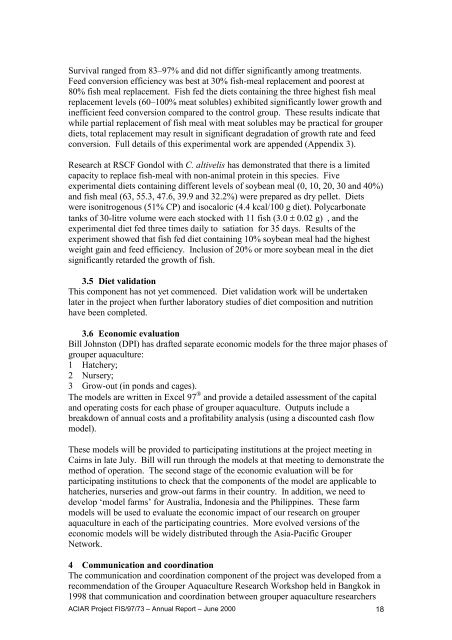ACIAR Project FIS/97/73 - Library - Network of Aquaculture Centres ...
ACIAR Project FIS/97/73 - Library - Network of Aquaculture Centres ...
ACIAR Project FIS/97/73 - Library - Network of Aquaculture Centres ...
Create successful ePaper yourself
Turn your PDF publications into a flip-book with our unique Google optimized e-Paper software.
Survival ranged from 83–<strong>97</strong>% and did not differ significantly among treatments.Feed conversion efficiency was best at 30% fish-meal replacement and poorest at80% fish meal replacement. Fish fed the diets containing the three highest fish mealreplacement levels (60–100% meat solubles) exhibited significantly lower growth andinefficient feed conversion compared to the control group. These results indicate thatwhile partial replacement <strong>of</strong> fish meal with meat solubles may be practical for grouperdiets, total replacement may result in significant degradation <strong>of</strong> growth rate and feedconversion. Full details <strong>of</strong> this experimental work are appended (Appendix 3).Research at RSCF Gondol with C. altivelis has demonstrated that there is a limitedcapacity to replace fish-meal with non-animal protein in this species. Fiveexperimental diets containing different levels <strong>of</strong> soybean meal (0, 10, 20, 30 and 40%)and fish meal (63, 55.3, 47.6, 39.9 and 32.2%) were prepared as dry pellet. Dietswere isonitrogenous (51% CP) and isocaloric (4.4 kcal/100 g diet). Polycarbonatetanks <strong>of</strong> 30-litre volume were each stocked with 11 fish (3.0 ± 0.02 g) , and theexperimental diet fed three times daily to satiation for 35 days. Results <strong>of</strong> theexperiment showed that fish fed diet containing 10% soybean meal had the highestweight gain and feed efficiency. Inclusion <strong>of</strong> 20% or more soybean meal in the dietsignificantly retarded the growth <strong>of</strong> fish.3.5 Diet validationThis component has not yet commenced. Diet validation work will be undertakenlater in the project when further laboratory studies <strong>of</strong> diet composition and nutritionhave been completed.3.6 Economic evaluationBill Johnston (DPI) has drafted separate economic models for the three major phases <strong>of</strong>grouper aquaculture:1 Hatchery;2 Nursery;3 Grow-out (in ponds and cages).The models are written in Excel <strong>97</strong> ® and provide a detailed assessment <strong>of</strong> the capitaland operating costs for each phase <strong>of</strong> grouper aquaculture. Outputs include abreakdown <strong>of</strong> annual costs and a pr<strong>of</strong>itability analysis (using a discounted cash flowmodel).These models will be provided to participating institutions at the project meeting inCairns in late July. Bill will run through the models at that meeting to demonstrate themethod <strong>of</strong> operation. The second stage <strong>of</strong> the economic evaluation will be forparticipating institutions to check that the components <strong>of</strong> the model are applicable tohatcheries, nurseries and grow-out farms in their country. In addition, we need todevelop ‘model farms’ for Australia, Indonesia and the Philippines. These farmmodels will be used to evaluate the economic impact <strong>of</strong> our research on grouperaquaculture in each <strong>of</strong> the participating countries. More evolved versions <strong>of</strong> theeconomic models will be widely distributed through the Asia-Pacific Grouper<strong>Network</strong>.4 Communication and coordinationThe communication and coordination component <strong>of</strong> the project was developed from arecommendation <strong>of</strong> the Grouper <strong>Aquaculture</strong> Research Workshop held in Bangkok in1998 that communication and coordination between grouper aquaculture researchers<strong>ACIAR</strong> <strong>Project</strong> <strong>FIS</strong>/<strong>97</strong>/<strong>73</strong> – Annual Report – June 2000 18
















